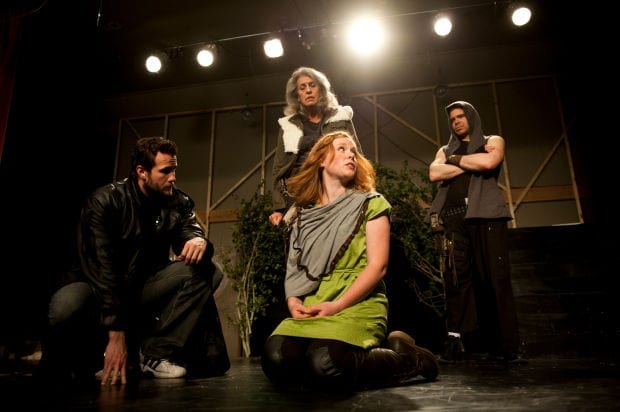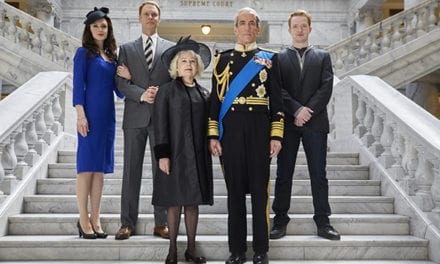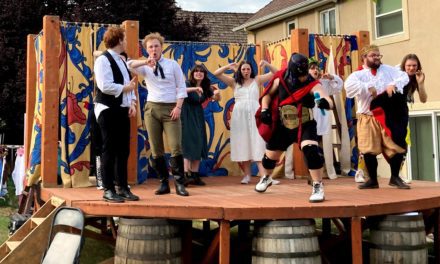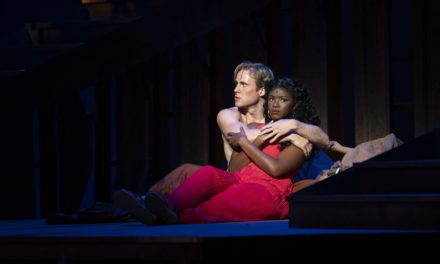PROVO — The most important thing to know about The Echo Theatre’s production of A Midsummer Night’s Dream is that it definitely does not look like a typical production of Midsummer. Instead of nymph-like fairies there are zombie creatures that torment the mortals in the forest. Tights and flowing dresses have been replaced by combat boots and worn clothing. And a shadow of foreboding danger has been cast across the normally lighthearted love tale. In short, the Echo’s production of A Midsummer Night’s Dream, set in a post-apocalyptic world, breaks all the rules about what this Shakespeare comedy should be.
Director Hailey Nebeker was responsible for this drastic reimagining of A Midsummer Night’s Dream. Her choice to emphasize the mortal’s peril added a layer of drama not normally seen in this play. I also appreciated Nebeker’s decision to insert physical comedy in most of the play’s scenes, especially in Bottom’s scenes and the scenes where the four mortal lovers were in the forest. Nebeker’s direction was generally fluid and helped the action move quickly. However, I feel like the “rules” of how the mortal and fairy worlds interact were too vague. A lot of the humor in A Midsummer Night’s Dream happens because of the collision between the inhabitants of these two realms; having the fairies fight with Lysander, Demetrius, and the mechanicals was distracting and didn’t make sense. But this only happened in about three scenes and was not a major problem from the play.
A director’s vision is nothing, though, without a strong cast to carry it out. And A Midsummer Night’s Dream has one of the strongest casts I have seen at the Echo. My favorite performer of the evening was David Lassetter as Oberon and Theseus. Lassetter’s height, booming voice, and dignified mannerisms make him a natural fit for a Shakespearean kingly role. Lassetter created a nice contrast between his two roles; his Theseus seemed to govern by strength and edict, while his Oberon preferred a personal touch when dealing with his subjects. And Lassetter was also noteworthy for showing Oberon’s character growth as he realized his cruelty towards Titania. This is an important aspect of the character that is—unfortunately—neglected in most productions.
Jeffrey Lee Blake created another strong performance as Bottom. Blake was most fun when showing Bottom’s unbridled enthusiasm for Pyramus and Thisbe, the play that his character (and several others) perform at the end of Midsummer. Blake was hilarious in every scene (especially when performing as Pyramus), and he never failed to make me laugh. However, he was also capable of showing a deep, tender side of Bottom as the character woke up from his own “dream.”

Front: David Lassetter as Theseus, Heidi Smith Anderson as Hermia. Rear: Jan Williams as Egeus and Jared Lynton as Demetrius.
The two pairs of lovers were also commendable, especially as they interacted with each other. Cherie Julander was a hopeless Helena, and her despair when she was spurned by Demetrius made her highly sympathetic. Her Demetrius, played by Jared Lynton, was believable as a tough man who had survived the apocalypse, and once his character fell in love with Helena the two had great romantic chemistry. Michael Hanks, as Lysander, excelled in handling the language of the play, and he never looked uncomfortable conveying his character’s emotions through Shakespeare’s poetry. Finally, Heidi Smith Anderson created a passionate Hermia, and it was easy to see why her feelings for Lysander were the driving force of her actions. The only thing I wish were different about these characters’ interactions occurred when the men were fighting over Helena. The two engaged in a thumb war, arm wrestle, and other minor contests for Helena’s love when in the coarse world of the play they should have been pulling knives on each other.
In addition to playing Helena, Cherie Julander also served as the costume designer. Julander’s costumes looked like a Shakespeare-Mad Max mashup, and I enjoyed seeing the different ways that the characters had cobbled together their wardrobe. The white, multilayered costumes for Titania and Oberon were also a nice touch in the way that they set apart these characters from the humans. The set, designed by Jeffrey Lee Blake, consisted of just one upstage piece, but it matched the setting of the play because of the details that made the platform look decayed.
I have lost count of the number of times that I have seen A Midsummer Night’s Dream. Yet, the unique visual style and the dark setting revitalized the show. This isn’t a typical Midsummer, which should make it an enjoyable evening for both newcomers to Shakespeare newcomers and veteran audience members.






